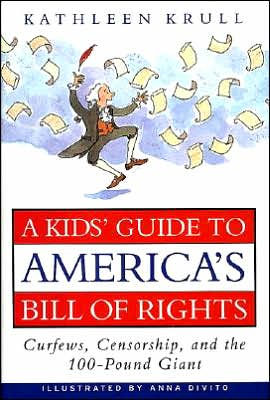These ten very important promises are part of the ultimate laws of the land -- the guidelines all newer laws are supposed to respect.
You recall the Constitution. It's the very important document that spells out how the United States is to be governed.
1. It begins with "We the people."2. It says that the majority of the people, through democratically elected representatives, govern the country.
3. It was drawn up in 1787 and went into effect two years later.
4. It sets up a balance between national (or federal) government and state governments.
5. It further separates powers by establishing three branches of national government: the executive (the president), the legislative (the Congress), and the judicial (the Supreme Court).
6. These branches of government check up on each other through a system of checks and balances, so no one branch gets too powerful.
7. No law can be passed that disagrees with the Constitution.
8. A lot of arguing went into the making of it.
9. A lot of arguing has gone on about it ever since.
One of the beauties of our Constitution is its flexibility: It was built to last. In fact, its meaning changes with the times. It can even mean totally opposite things at different points in history. For example, in an 1896 Supreme Court case called Plessy v. [short for versus] Ferguson, racial segregation was found constitutional, which means okay according to the Constitution. But as of 1954, in another case called Brown v. Board of Education, the Court decided exactly the opposite: Segregation was unconstitutional, and therefore it was outlawed.
But no sooner was the Constitution wrestled into words than the mysteries and complications began. All sorts of people criticized it for all sorts of reasons. The general public's sorest spot was the Constitution's lack of a Bill of Rights. Having branches of government check on each other was nifty, but it wasn't enough. Minorities needed protection from the majority. Individual people needed protection from the government.
These critics argued that a powerful central government without safeguards for people was dangerous. Why? Because historically governments try to expand their power at the expense of individual liberty. We take such liberty for granted now, but back then American people suffered a lot of abuse without it. One critic actually compared a constitution lacking a bill of rights to arsenic that would poison your body; another called government a runaway horse that would break people's necks. One particularly violent critic said that he would rather chop off his right hand than sign a constitution without a bill of rights.
As it turned out, only because of pledges to add to it was the Constitution even ratified (formally approved). Public opinion was loud and clear: The Constitution lacked a certain something.
The True Story of the Bill of Rights
The man of the hour in this story is James Madison. This congressman from Virginia had been an especially active participant in all the arguments about -- and creation of -- the Constitution.
Madison wrote the first draft of the Bill of Rights in 1789 and made it his business to get it accepted. He didn't invent the ideas in it -- the Bill of Rights represented the summing up of decades of revolutionary thought. Instead, Madison borrowed things here and there, from
- various states' constitutions
- sources such as England's Magna Carta -- a document, approved by King John in 1215, that protected people against royal abuses of power
- his fellow Virginian George Mason, who had written Virginia's Declaration of Rights
Madison's life was not easy. Despite public support for a bill of rights, most politicians were either indifferent or else actively hostile to his pet project. It took him two and a half years of debates -- and, frankly, badgering his fellow congressmen -- before he got the necessary agreement from the majority of states.
The 100-Pound GiantFor his persistence with the Bill of Rights, James Madison will forever be known as its "father." But a number of things worked against him as he shepherded it through the political process. One was his own doubt. He thought there were probably more urgent issues around. Privately he was skeptical about its value and was even known to refer to it as "a nauseous project." But Madison did see the Bill of Rights as a way to increase his popularity with the public. He used it as a campaign issue in his close race against James Monroe for election to the first House of Representatives.
Another problem was Madison himself. He made a very poor first impression and had to work hard to overcome it. He was short and weighed just one hundred pounds. He was sickly, nervous, and shy, with such a weak voice that listeners often could not hear him. He delayed decisions as long as possible, so many people found him timid and indecisive.
Madison was smart. He had graduated from college in two years and then gone intopolitics. He also had a "secret weapon" in his wife, the energetic and enormously popular Dolley Madison. As an active delegate to the ConstitutionalConvention in 1787, James Madison was the only one who thought to take notes(thus providing our only record of how the Constitution came to be written). The wife of one of the other delegates called Madison a "gloomy stiff creature," but others were kinder. Thomas Jefferson said that he knew of no man in all of America and Europe with more integrity or with "an abler head" than Madison.
Madison won that election against Monroe, and more elections later. Eventually, in 1809, he became the fourth president of the United States. And if you ever come...
A Kids' Guide to America's Bill of Rights. Copyright © by Kathleen Krull. Reprinted by permission of HarperCollins Publishers, Inc. All rights reserved. Available now wherever books are sold.



